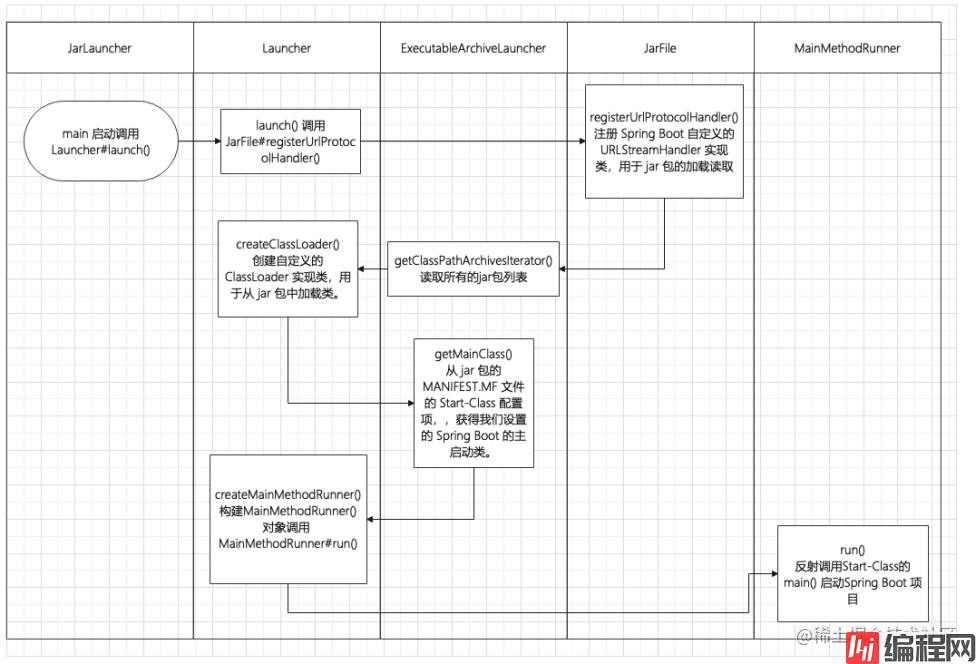Python 官方文档:入门教程 => 点击学习
目录引言Spring Boot 打包插件SpringBoot Fatjar 的组织结构MaiNFEST.MF 元信息启动原理源码分析JarLauncherLauncherProper
很多初学者会比较困惑,spring Boot 是如何做到将应用代码和所有的依赖打包成一个独立的 Jar 包,因为传统的 Java 项目打包成 Jar 包之后,需要通过 -classpath 属性来指定依赖,才能够运行。我们今天就来分析讲解一下 SpringBoot 的启动原理。
Spring Boot 提供了一个名叫 spring-boot-Maven-plugin 的 maven 项目打包插件,如下:
<plugin>
<groupId>org.springframework.boot</groupId>
<artifactId>spring-boot-maven-plugin</artifactId>
</plugin>可以方便的将 Spring Boot 项目打成 jar 包。 这样我们就不再需要部署 Tomcat 、Jetty等之类的 WEB 服务器容器啦。
我们先看一下 Spring Boot 打包后的结构是什么样的,打开 target 目录我们发现有两个jar包:

其中,springboot-0.0.1-SNAPSHOT.jar 是通过 Spring Boot 提供的打包插件采用新的格式打成 Fat Jar,包含了所有的依赖;
而 springboot-0.0.1-SNAPSHOT.jar.original 则是Java原生的打包方式生成的,仅仅只包含了项目本身的内容。
我们将 Spring Boot 打的可执行 Jar 展开后的结构如下所示:

MANIFEST.MF 文件提供 Jar包的元数据,声明了 jar 的启动类;org.springframework.boot.loader :Spring Boot 的加载器代码,实现的 Jar in Jar 加载的魔法源。我们看到,如果去掉BOOT-INF目录,这将是一个非常普通且标准的Jar包,包括元信息以及可执行的代码部分,其/META-INF/MAINFEST.MF指定了Jar包的启动元信息,org.springframework.boot.loader 执行对应的逻辑操作。
元信息内容如下所示:
Manifest-Version: 1.0
Spring-Boot-Classpath-Index: BOOT-INF/classpath.idx
Implementation-Title: springboot
Implementation-Version: 0.0.1-SNAPSHOT
Spring-Boot-Layers-Index: BOOT-INF/layers.idx
Start-Class: com.listenvision.SpringbootApplication
Spring-Boot-Classes: BOOT-INF/classes/
Spring-Boot-Lib: BOOT-INF/lib/
Build-jdk-Spec: 1.8
Spring-Boot-Version: 2.5.6
Created-By: Maven Jar Plugin 3.2.0
Main-Class: org.springframework.boot.loader.JarLauncher它相当于一个 Properties 配置文件,每一行都是一个配置项目。重点来看看两个配置项:
Spring Boot 的启动原理如下图所示:

JarLauncher 类是针对 Spring Boot jar 包的启动类, 完整的类图如下所示:

其中的 WarLauncher 类,是针对 Spring Boot war 包的启动类。 启动类 org.springframework.boot.loader.JarLauncher 并非为项目中引入类,而是 spring-boot-maven-plugin 插件 repackage 追加进去的。
接下来我们先来看一下 JarLauncher 的源码,比较简单,如下图所示:
public class JarLauncher extends ExecutableArcHiveLauncher {
private static final String DEFAULT_CLASSPATH_INDEX_LOCATION = "BOOT-INF/classpath.idx";
static final EntryFilter NESTED_ARCHIVE_ENTRY_FILTER = (entry) -> {
if (entry.isDirectory()) {
return entry.getName().equals("BOOT-INF/classes/");
}
return entry.getName().startsWith("BOOT-INF/lib/");
};
public JarLauncher() {
}
protected JarLauncher(Archive archive) {
super(archive);
}
@Override
protected ClassPathIndexFile getClassPathIndex(Archive archive) throws IOException {
// Only needed for exploded archives, regular ones already have a defined order
if (archive instanceof ExplodedArchive) {
String location = getClassPathIndexFileLocation(archive);
return ClassPathIndexFile.loadIfPossible(archive.getUrl(), location);
}
return super.getClassPathIndex(archive);
}
private String getClassPathIndexFileLocation(Archive archive) throws IOException {
Manifest manifest = archive.getManifest();
Attributes attributes = (manifest != null) ? manifest.getMainAttributes() : null;
String location = (attributes != null) ? attributes.getValue(BOOT_CLASSPATH_INDEX_ATTRIBUTE) : null;
return (location != null) ? location : DEFAULT_CLASSPATH_INDEX_LOCATION;
}
@Override
protected boolean isPostProcessinGClassPathArchives() {
return false;
}
@Override
protected boolean isSearchCandidate(Archive.Entry entry) {
return entry.getName().startsWith("BOOT-INF/");
}
@Override
protected boolean isNestedArchive(Archive.Entry entry) {
return NESTED_ARCHIVE_ENTRY_FILTER.matches(entry);
}
public static void main(String[] args) throws Exception {
//调用基类 Launcher 定义的 launch 方法
new JarLauncher().launch(args);
}
}主要看它的 main 方法,调用的是基类 Launcher 定义的 launch 方法,而 Launcher 是ExecutableArchiveLauncher 的父类。下面我们来看看Launcher基类源码:
public abstract class Launcher {
private static final String JAR_MODE_LAUNCHER = "org.springframework.boot.loader.jarmode.JarModeLauncher";
protected void launch(String[] args) throws Exception {
if (!isExploded()) {
JarFile.reGISterUrlProtocolHandler();
}
ClassLoader classLoader = createClassLoader(getClassPathArchivesIterator());
String jarMode = System.getProperty("jarmode");
String launchClass = (jarMode != null && !jarMode.isEmpty()) ? JAR_MODE_LAUNCHER : getMainClass();
launch(args, launchClass, classLoader);
}
@Deprecated
protected ClassLoader createClassLoader(List<Archive> archives) throws Exception {
return createClassLoader(archives.iterator());
}
protected ClassLoader createClassLoader(Iterator<Archive> archives) throws Exception {
List<URL> urls = new ArrayList<>(50);
while (archives.hasNext()) {
urls.add(archives.next().getUrl());
}
return createClassLoader(urls.toArray(new URL[0]));
}
protected ClassLoader createClassLoader(URL[] urls) throws Exception {
return new LaunchedURLClassLoader(isExploded(), getArchive(), urls, getClass().getClassLoader());
}
protected void launch(String[] args, String launchClass, ClassLoader classLoader) throws Exception {
Thread.currentThread().setContextClassLoader(classLoader);
createMainMethodRunner(launchClass, args, classLoader).run();
}
protected MainMethodRunner createMainMethodRunner(String mainClass, String[] args, ClassLoader classLoader) {
return new MainMethodRunner(mainClass, args);
}
protected abstract String getMainClass() throws Exception;
protected Iterator<Archive> getClassPathArchivesIterator() throws Exception {
return getClassPathArchives().iterator();
}
@Deprecated
protected List<Archive> getClassPathArchives() throws Exception {
throw new IllegalStateException("Unexpected call to getClassPathArchives()");
}
protected final Archive createArchive() throws Exception {
ProtectionDomain protectionDomain = getClass().getProtectionDomain();
CodeSource codeSource = protectionDomain.getCodeSource();
URI location = (codeSource != null) ? codeSource.getLocation().toURI() : null;
String path = (location != null) ? location.getSchemeSpecificPart() : null;
if (path == null) {
throw new IllegalStateException("Unable to determine code source archive");
}
File root = new File(path);
if (!root.exists()) {
throw new IllegalStateException("Unable to determine code source archive from " + root);
}
return (root.isDirectory() ? new ExplodedArchive(root) : new JarFileArchive(root));
}
protected boolean isExploded() {
return false;
}
protected Archive getArchive() {
return null;
}
}launch 方法会首先创建类加载器,而后判断是否 jar 是否在 MANIFEST.MF 文件中设置了 jarmode 属性。
如果没有设置,launchClass 的值就来自 getMainClass() 返回,该方法由PropertiesLauncher子类实现,返回 MANIFEST.MF 中配置的 Start-Class 属性值。
调用 createMainMethodRunner 方法,构建一个 MainMethodRunner 对象并调用其 run 方法。
@Override
protected String getMainClass() throws Exception {
//加载 jar包 target目录下的 MANIFEST.MF 文件中 Start-Class配置,找到springboot的启动类
String mainClass = getProperty(MAIN, "Start-Class");
if (mainClass == null) {
throw new IllegalStateException("No '" + MAIN + "' or 'Start-Class' specified");
}
return mainClass;
}目标类main方法的执行器,此时的 mainClassName 被赋值为 MANIFEST.MF 中配置的 Start-Class 属性值,也就是 com.listenvision.SpringbootApplication,之后便是通过反射执行 SpringbootApplication 的 main 方法,从而达到启动 Spring Boot 的效果。
public class MainMethodRunner {
private final String mainClassName;
private final String[] args;
public MainMethodRunner(String mainClass, String[] args) {
this.mainClassName = mainClass;
this.args = (args != null) ? args.clone() : null;
}
public void run() throws Exception {
Class<?> mainClass = Class.forName(this.mainClassName, false, Thread.currentThread().getContextClassLoader());
Method mainMethod = mainClass.getDeclaredMethod("main", String[].class);
mainMethod.setAccessible(true);
mainMethod.invoke(null, new Object[] { this.args });
}
}jar 包类似于 zip 压缩文件,只不过相比 zip 文件多了一个 META-INF/MANIFEST.MF 文件,该文件在构建 jar 包时自动创建。
Spring Boot 提供了一个插件 spring-boot-maven-plugin ,用于把程序打包成一个可执行的jar包。
使用 java -jar 启动 Spring Boot 的 jar 包,首先调用的入口类是 JarLauncher,内部调用 Launcher 的 launch 后构建 MainMethodRunner 对象,最终通过反射调用 SpringbootApplication 的 main 方法实现启动效果。
到此这篇关于SpringBoot为何可以使用Jar包启动的文章就介绍到这了,更多相关SpringBoot用Jar包启动内容请搜索编程网以前的文章或继续浏览下面的相关文章希望大家以后多多支持编程网!
--结束END--
本文标题: SpringBoot为何可以使用Jar包启动详解
本文链接: https://lsjlt.com/news/143605.html(转载时请注明来源链接)
有问题或投稿请发送至: 邮箱/279061341@qq.com QQ/279061341
2024-03-01
2024-03-01
2024-03-01
2024-02-29
2024-02-29
2024-02-29
2024-02-29
2024-02-29
2024-02-29
2024-02-29
回答
回答
回答
回答
回答
回答
回答
回答
回答
回答
0